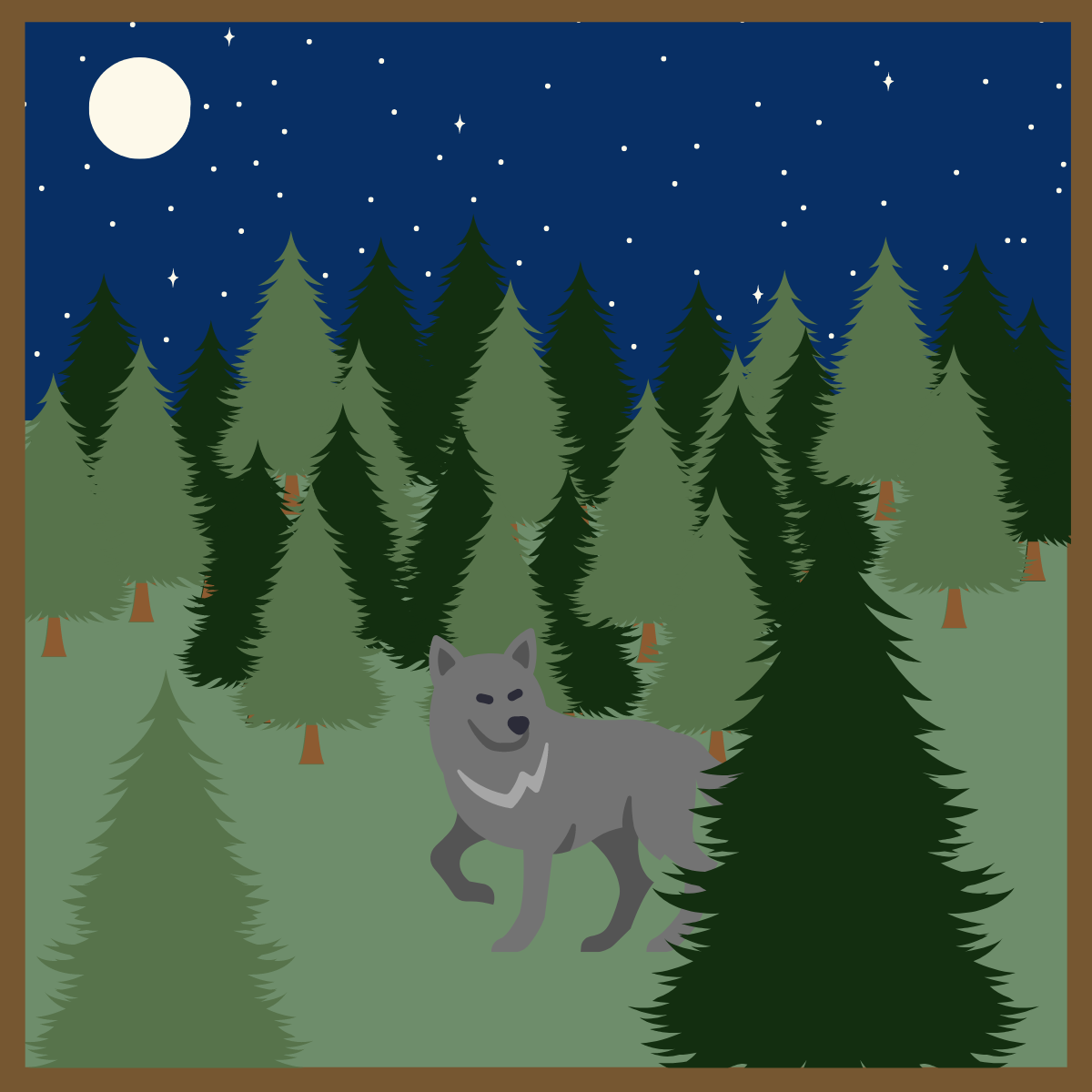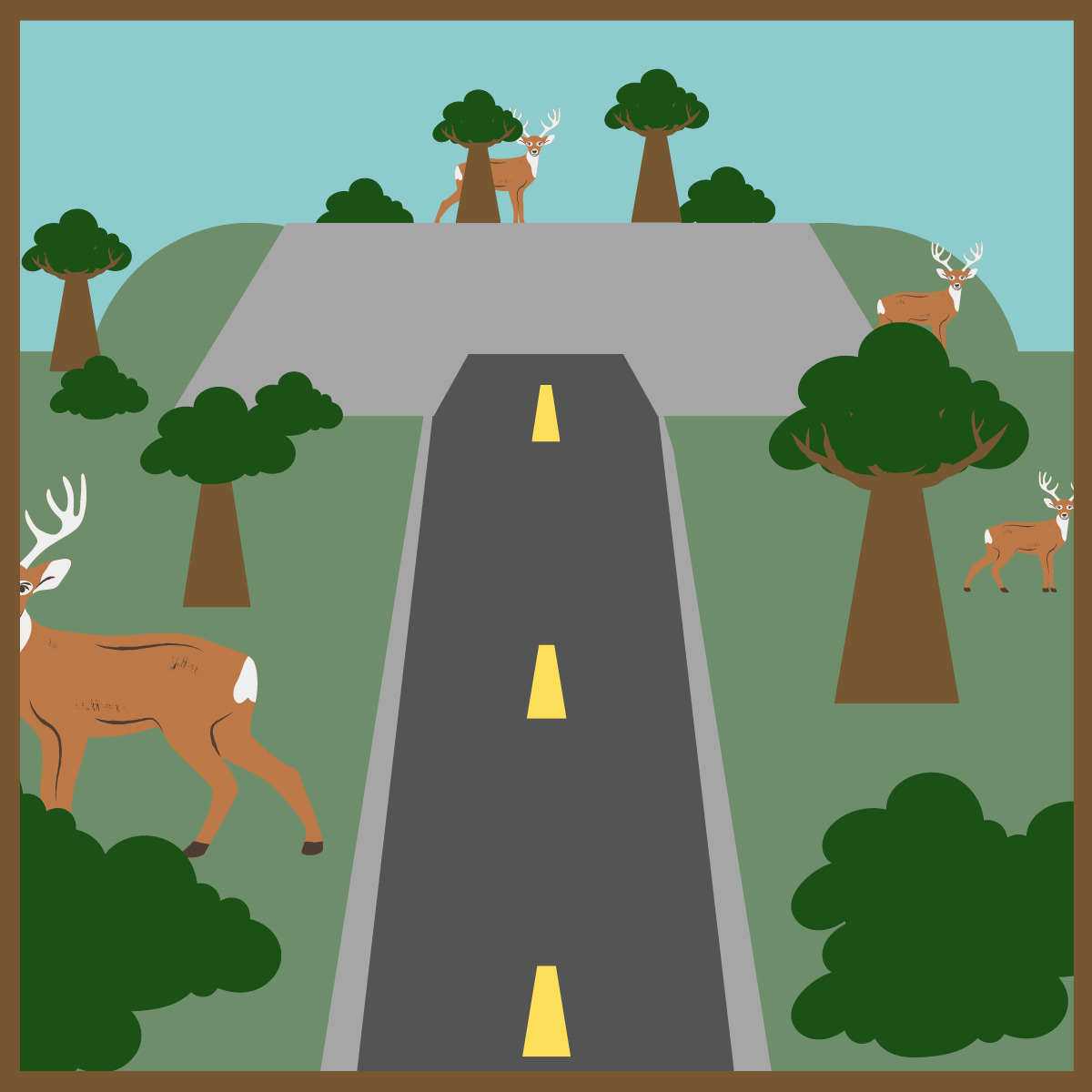Ecological
Rewilding


First of all, what is rewilding?
Basically, it’s a way of undoing some of the damage humans have inflicted upon an ecosystem. It’s meant to be as hands-off as possible to allow nature to take its course, but usually requires some human involvement in the beginning.[1]
Rewilding actions take many forms but can include building wildlife corridors to reconnect fragmented habitats, taking down dams, reintroducing apex predators or keystone species, allowing degraded forests to regenerate, and more.[1]
Graphics Courtesy of Tracy Wilkinson
In a successful rewilding project, the ecosystem continues to heal after the initial action without ongoing human support. Rewilding efforts must be well thought out, but when done correctly, rewilding is one of the most effective methods of restoring ecosystems to something resembling their original state. It increases biodiversity and can help lessen the consequences of climate change.[1]
Case Study: Highway 97 Wildlife Crossing
In central Oregon, a wildlife corridor was built to let deer travel under a highway without putting themselves (or the passing cars) at risk. The project included two underpasses and miles of fencing to direct the deer to the crossing. Traffic accidents due to crossing wildlife have gone down, and the deer can now safely access their habitat on both sides of the highway.[2]
Logged Forest Natural Regeneration
In many cases, the best strategy for rewilding is letting nature take its course without any initial action whatsoever, or even deliberate inaction. For example, should a farmer wish to allow some of their land to “go wild,” a first simple step would simply be to stop mowing. By leaving nature in peace, it will often find its own way. All over the world, natural forest regeneration is progressing at different scales, from backyard regrowths to entire forests.[3]
Economic
Sustainable Economy
One of nature’s biggest enemies is the current economic system used by much of the world. As long as this system continues, the mindset of constant growth will continue environmental degradation. However, we can make a difference by eliminating unnecessary consumption (buying things you don’t really need). Because the economy plays such a central part in the world, changing parts of it would have huge positive impacts on the environment. Different groups and people approach sustainable economics in different ways. One approach is to ‘put a price on the priceless’ and make companies pay for the environmental damage they cause, making less eco-friendly products more expensive and more eco-friendly products cheaper.[4]
Case Study: Oregon Nonprofit
One Oregon nonprofit has proposed a way for boom-and-bust forest communities to move toward a local economic model that is sustainable economically, socially, and environmentally. Oregon’s private forests have a lot of potential for carbon sequestration and storage, but unfortunately, 4.4 million acres of them lay in the hands of corporations that log them unsustainably for profit.[5]
The nonprofit’s Green New Deal-inspired proposal suggests a method of converting corporate-owned forests to locally-owned lands. After the land is bought from the corporations, it would be transferred to local workers through a “working forest conservation easement” on the property’s title, preserving both the forest and the livelihoods of the locals who originally worked for the corporations.[6]
Proforestation
What's that? Think Pro-forest. Proforestation is the practice of protecting already-existing forests.
30 x 30
The term ‘30 x 30’ pops up a lot in environmental conversations, but many people don’t know what it actually is. In short, it’s both a national and global movement to protect 30% of lands and coastal waters by 2030. The movement is trying to pass legislation that will protect public lands from destructive actions by humans, and it is prioritizing the voices of Indigenous peoples and local communities. Right now, 12% of U.S. lands are protected.[7] That means more than half of the goal still remains, and there’s less than a decade left!
Case Study: Keep Waldo Wild
A nature protection project like those needed to accomplish 30 x 30’s goal is underway right on our doorstep. The Juniper Group, a subdivision of the Oregon Chapter of the Sierra Club, is attempting to ensure heightened protection of 75,000 acres of undisturbed forest around Waldo Lake through their Keep Waldo Wild campaign. There is currently no permanent protection from logging and other destructive activities in the areas South and East of the lake, and the Juniper Group is pursuing legislative protection to rectify that issue.[8]
After carefully weighing the impacts of various solutions on diverse stakeholders, the group is proposing a “Waldo Backcountry Recreation Area,” which would protect “...against new human development, new trails, logging, and expanding motorized access beyond the existing roads” while still allowing the running and mountain biking communities access to the space.[9]
Read more at https://oregon2.sierraclub.org/juniper-group/waldo/keep-waldo-wild.
[1] True Nature Foundation. "What is rewilding?" True Nature Foundation, truenaturefoundation.org/what-is-rewilding/. Accessed 6 July 2022.
[2] "Highway 97 wildlife crossings." Youtube, uploaded by The Bulletin, 11 Aug. 2014, www.youtube.com/watch?v=Mvtt1c82NVg&t=149s.
[3] Weir, Kirsten. "Second Nature." The Nature Conservancy, 28 Feb. 2022, www.nature.org/en-us/magazine/magazine-articles/second-nature-reforestation/.
[4] Chouinard, Yvon, et al. "The Sustainable Economy." Harvard Business Review, Oct. 2011, hbr.org/2011/10/the-sustainable-economy.
[5] Coast Range Association. "A Green New Deal Proposal." Climate & Oregon's Industrial Forests, coastrange.org/wp-content/uploads/2021/01/A-GND-for-Industrial-Forests-FINAL-1.20.21.pdf. Accessed 6 July 2022.
[6] Willer, Chuck. (2021). Climate and Oregon’s Industrial Forests: A Green New Deal Proposal. Coast Range Association, Oregon.
[7] "30 x 30 movement." The Wilderness Society, www.wilderness.org/key-issues/30-x-30-movement. Accessed 16 July 2022.
[8] "KWW Protection Plan." The Juniper Group, Sierra Club, oregon2.sierraclub.org/juniper-group/waldo/KWW-Protection. Accessed 10 July 2022.
[9] "Keep Waldo Wild." The Juniper Group, Sierra Club, https://oregon2.sierraclub.org/juniper-group/waldo/keep-waldo-wild. Accessed 10 July 2022.
Learn More!
Logging Fungal Networks Biodiversity Climate Change Carbon Storage Connections